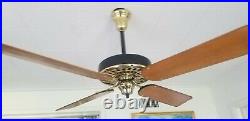
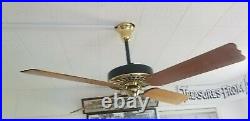
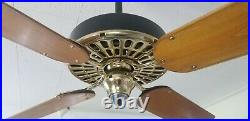
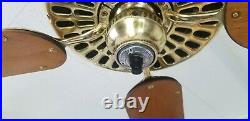

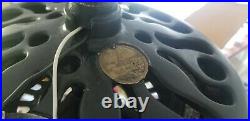


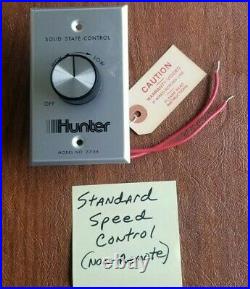

6 MONTH LEAD TIME – TOTALLY BACKLOGGED AND THESE THINGS TAKE TIME. 1916 ANTIQUE VINTAGE HUNTER TUERK CEILING FAN. This is the fan the proceeded the C-17 that came out in 1917. This fan is the very first with the modern styling like the C-17 but NOT THE SAME as a C17. REBUILT W REMOTE CONTROL & Youtube VIDEO. This is an original 1914-16 Hunter Tuerk Type C Ceiling Fan. Hunter first produced the Tuerk in 1906 that had wavy curls in the bottom plate. This version of the Tuerk changed the bottom plate to the more common modern style used on Hunter Ceiling fans today, so you might say this is the great granddaddy of all the Hunter Fans. Many collectors confuse this fan with the C-17 that came out in 1917 but they are not the same. You will see the top of the motor is different, the body of the motor is thicker and the armature is also thicker than the C-17. This fan also is about 15% more powerful than the C-17 and moves more air. This fan also features the “hidden” blade brackets that do not show on the blade bottom, showing off the original blades, which happen to be about 25% lighter than other vintage Hunter 52 blades, making this fan spin even faster. If you own a home built between 1890 and 1920 this would be proper fan to use in a restoration. Many homes built in the late 1800s or early 1900’s did not have electricity till 1915 so this would have been the first fan in the home. If you have high ceilings or large room you need a more powerful fan and this puts out about 30% more than most fans on the market yet draws only 100 watts on the medium speed which is more than enough for most applications. (60 watts low & 175 watts on high). It is simply amazing you can own an appliance used on a daily basis that is over 100 years old. There is no reason this unit should ever fail for another 100 years. They were built to last decades with an oil bath bearing system that puts very little wear on the bearings. The motor windings have all been relaminated to prevent any shorting. The refinishing should also last decades. If your home is in New York you would be extra proud of a fan built in your home state. If you live in the Syracuse / Fulton area even more so as Hunter started in Syracuse and moved just 30 miles to Fulton shortly thereafter. As such, many people sell us their antique fan as they have neither the time or expertise to restore them. Restoring a hundred year old fan requires lot of time, special materials, experience and know how. It is a kind of art form you can spend 5 years learning all the details needed to do it correctly. Just a few of the many steps required. Replace the input AC lead in wires. Relaminate motor coils & wiring. Resurface motor shaft, coils and armature. Refinish motor, brackets, downpipes, canopy and blades. Rewire speedcoil, lights & switches if applicable. THIS ALSO INCLUDES OUR EXCLUSIVE REMOTE CONTROL OR A STANDARD SPEED CONTROL. Like most all ceiling fans built from 1900 to 1970 this uses a “Shaded Pole” motor that DOES NOT need capacitors to start. By eliminating capacitors you improve reliability. These also have more torque than capacitor start motors. However, these “Shaded Pole” motors DO NOT work with any of the ceiling fan remote controls on the market. Our Remote control is THE ONLY ONE that work with “Shaded Pole” motors. We have developed one just for this market and it allows you 3 speeds. Medium & low speeds are individually adjustable. The Remote Control is mounted in a 3 gang outlet / switch box. Choice of mounting options include. Cut out of your existing wall switch area to make room for the 3 gang box. Cut out a hole in your ceiling near the fan and mount it there as a wall switch on your ceiling. If there is attic access you can go into the attic and place control box just above the fan without cutting any holes. Cut out a hole in your attic / craw space next to your fan on the ceiling. Place unit in your attic / craw space then cover the hole with a special plate designed to cover drywall holes. Here is a link that sells a easy 7″ x 5″ cover plates for holes cut in your ceiling to fit 3 gang control box into. If using a swag style power cord the switch box can be placed near the wall outlet where it plugs in. Great for bedrooms where fan speed adjustment requires you to get out of bed to adjust a wall control or pull switch. Great for high ceilings where a long pull switch string is not desirable (assuming you still have a pull switch installed). If you happen to have an existing antique ceiling fan with a working speed switch, using this remote instead will preserve your original (and fragile) rotary speed control switch. You simply keep your original switch on high and let this remote do the speed changing. The Memphis-based company produces more than 300 residential, commercial, and industrial ceiling fan models under such names as the 1886 Limited Edition, the Hunter Original, the Seville, and the Fantasy Flier. Accounting for nearly one percent of the room air conditioner market, Hunter has manufacturing operations in Memphis as well as in Mexico and the Far East. The Hunter Fan Company was founded in 1886 in Syracuse, New York, by James C. Hunter and his father, John Hunter, immigrants from Ireland. Originally known as the Hunter Fan and Ventilating Company, the fledgling business first engaged in the manufacture of water motors and meters. The founders expanded their operations to include the production of belt-driven fans, the power for which was first provided by water motors and later by the Tuerk Electric Motor, which they developed. The Hunter reputation for quality was established early in the company’s history: some of these earliest belt-driven fans are still in use today after more than a century. In 1889 the growing company moved its operations to Fulton, New York, where it would spend the next fifty years at a plant located at Front Street, extending from Huling Street to Tolbot Street. Twelve years later, upon the death of John Hunter, his six sons incorporated the company and focused their attention on expanding the production of ceiling fans. By the early 1920s, the company was widely known for its high-quality electric fans. Noted for their elaborate “Dragon” design, the electric fans were best suited for ceilings from ten feet and up and were advertised as ready for electric lights. By the early 1920s the Hunter name was widely known throughout the United States and the world. The fans were especially popular in India and China, and throughout the Far East, where thousands were exported each year. By the mid-1920s, desk oscillating fans had been added to the Hunter product line. In 1936, after purchasing the fan division of Century Electric Company, Hunter began manufacturing large pedestal air circulating fans and direct exhaust fans as well, which were used by many of the finest hotels and stores. Two years later, the company began producing attic fans as well. With the onset of World War II, the company suspended the manufacturing of ventilating equipment for consumer use and concentrated its efforts on aiding the war effort, producing belt fans for government use in Army hospitals and barracks, and portable ventilators and oscillators for the Navy. With the postwar boom in the U. Economy, Hunter expanded its operations to keep up with the growing need for commercial and industrial ventilating equipment. In 1946 the company moved its plant from Fulton to its present location in Memphis in order to take advantage of the rapid industrial expansion of the South. Three years later, Hunter was acquired by Robbins & Meyers, Inc. For the next 45 years, Hunter operated as a wholly owned subsidiary of Robbins & Meyers, producing a complete line of residential, commercial, and industrial fans. Although Hunter performed consistently well throughout the 1960s and 1970s, by the mid-1980s the company’s limited line of ventilating products, combined with the entrance of a number of new competitors into the market, brought on financial crisis. Clouspy, who took over as company chairman and chief executive officer. During the two years following the takeover, the management team guided the company through the financial crisis, developing a strategy of product diversification that made Hunter profitable once again. Solidifying its financial base by refinancing its remaining debt, Hunter was now in position to expand its operations through acquisition. A designer and importer of residential lighting products. In June 1987, the company went public under the name Hunter-Melnor, Inc. The company’s renewed success was attributed in part to the management style of Clouspy and his colleagues, who opted for a highly decentralized team of four presidents, each responsible for one division of the company. As Hunter was expanding its operations during this period, the company again underwent an organizational change. In 1988, just a year after it had gone public, the company was privatized through a leveraged buyout led by the investment firm Leach McMicking. The transition, however, did not impede the turnaround of the company. Boosted by the strong performance of the Melnor group and its line of garden chemical products, the Hunter group was able to take advantage of the expanding fan market, landing four new major customers: Payless Cashways, Kmart, Wal-Mart, and Target. Fan sales, once limited primarily to the South, had extended throughout the nation. While Miami, for instance, represented Hunter’s top sales city in 1984, Phoenix headed the list in 1987, followed by Philadelphia and Chicago. Driven by these forces, fan sales jumped from 1.2 million units in 1980 to 16 million in 1987, the company’s one-hundredth year of operation. As Hunter-Melnor, led by president and chief executive officer G. Competing in a market driven by such volatile factors as the weather, new home construction, and remodeling, Hunter and the rest of the industry were especially vulnerable to the recessionary economy of the late 1980s and early 1990s. Nevertheless, Hunter continued its pattern of growth by focusing on the remodelling segment of the industry, where the demand for its upscale units represented the greatest potential for profit. While these strategies kept Hunter-Melnor at the forefront of the industry, the company’s profitable Hunter division was weighted down by debt affecting the entire company. To alleviate this problem and make each division bear the responsibility for its own debt, Hunter-Melnor was divided into two corporations in September 1991. Under the reorganization plan, Robert Beasely took over as the new president and chief executive officer of Hunter Fan. Kenroy International was placed under its control as a subsidiary. Less encumbered by debt, Hunter Fan was able to direct its attention and resources to advertising and product development. While continuing to emphasize the home fashion aspect of its ceiling fans, adding such models as the Fantasy Flier–a fan replica derived from a naval archival drawing of an F4U fighter plane&mdashø its product line, Hunter Fan launched the largest advertising campaign in the history of the industry. The company set the stage for its aggressive strategy in the summer of 1992 by reformatting its logo across all of its product lines, incorporating a new Hunter green color and introducing upscale packaging graphics. Starting in May 1993, the company began advertising a wide variety of its ceiling fans in 30-second prime time television spots and in such popular magazines as Newsweek and Sports Illustrated, in which two-page, four-color spreads appeared. The unprecedented advertisements emphasized both the multipurpose dimension of ceiling fans, showing their effectiveness in areas as diverse as the bathroom and the porch, and the economical advantages of the product, making the case that fans are a cost-effective alternative to air conditioning. In the summer of 1993, the company introduced more than a hundred new lighting fixtures, including models featuring weathered metal, colored glass, and textured finishes, strengthening its reputation as the leading supplier of upscale decorative fans. In October of that same year, the company added another potentially profitable market to its repertoire when the United States Food and Drug Administration approved its air purifiers as Class II medical devices. Accordingly, the company launched a national print ad campaign targeting consumers with ads in magazines such as Ladies Home Journal, Reader’s Digest, and Modern Maturity. Perhaps the company’s most innovative and publicized campaign began in February 1995, seven months into a major league baseball strike. Going against conventional wisdom, Hunter Fan unveiled a baseball-themed ceiling fan and introduced a nationwide “Why I Love Baseball” program, calling for baseball fans to write letters explaining why they cherish the national pastime. As an added incentive to the fans, the company awarded trips to the Baseball Hall of Fame in Cooperstown, New York, and ceiling fans to winners of the contest, which was judged by such well-known baseball fans as filmmaker Ken Burns, Sporting News editor John Rawlings, and the “Clown Prince of Baseball, ” Max Patkin. Instead of proving a liability, the strike actually succeeded in generating widespread interest in the contest and in the novelty item. With more than 225 U. Radio stations and a host of television stations and major publications covering the campaign, Hunter Fan was able to reap benefits from what may have first appeared to be a marketing disaster: in just the first few weeks of the campaign, the baseball fan became one of the company’s leading sellers. Behind the strength of its bold marketing strategy, Hunter Fan has entered its second century of operation well positioned for continued expansion. How far past this level the company will go depends largely on the state of the U. Construction market, the success of new competitors to the industry, and the height of the mercury on the thermometer. Track Page Views With. Auctiva’s FREE Counter. The item “1914 1915 1916 ANTIQUE VINTAGE HUNTER TUERK CEILING FAN-Fulton & Syracuse NY” is in sale since Friday, June 5, 2020. This item is in the category “Home & Garden\Lamps, Lighting & Ceiling Fans\Ceiling Fans”. The seller is “jj-do-it-products” and is located in Syracuse, New York. This item can be shipped to United States, Canada, United Kingdom, Denmark, Romania, Slovakia, Bulgaria, Czech republic, Finland, Hungary, Latvia, Lithuania, Malta, Estonia, Australia, Greece, Portugal, Cyprus, Slovenia, Japan, China, Sweden, South Korea, Taiwan, Thailand, Belgium, France, Hong Kong, Ireland, Netherlands, Poland, Spain, Italy, Germany, Austria, Bahamas, Israel, Mexico, New Zealand, Singapore, Switzerland, Norway, Saudi arabia, United arab emirates, Qatar, Kuwait, Bahrain, Croatia, Malaysia, Bangladesh, Brunei darussalam, Bolivia, Egypt, French guiana, Guernsey, Gibraltar, Guadeloupe, Iceland, Jersey, Jordan, Cambodia, Liechtenstein, Luxembourg, Monaco, Macao, Martinique, Nicaragua, Pakistan, Paraguay, Uruguay, South africa, Barbados, Bermuda, Cayman islands, Sri lanka, Maldives, Oman, Reunion.
- Model: Tuerk “C”
- Color: Brass
- MPN: Does Not Apply
- Brand: Hunter
- Fan Width: 52″
- Features: Remote Control
- Room: any



